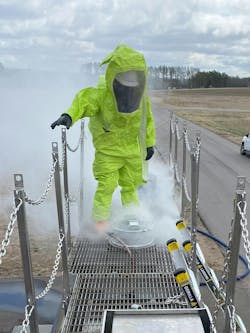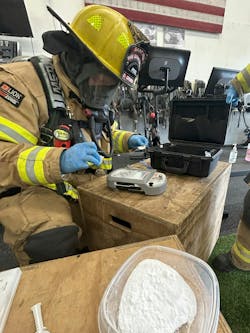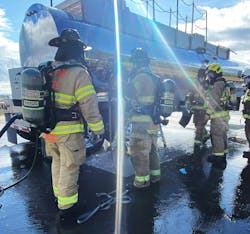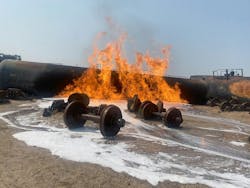Technical Rescue: Using Physical and Chemical Properties to Guide Hazmat Response
The science of hazmat response can feel intimidating. However, rest assured, even the most skeptical of you can comprehend and utilize scientific principles to gain a competitive advantage over any hazmat scene. You don’t need to be able to write a
doctoral-level dissertation regarding the various forms of chemical bonds. What you need is down-and-dirty knowledge.
Below, you will find “firefighter” definitions of some of the most critical science terms to guide your response, from reconnaissance to decontamination. I forgo technical definitions to instead discuss more practically, to explain how and why the terms matter (i.e., the accuracy of the application to us) to a response.
State of matter
A practical way to look at the state of matter: How big is the problem that confronts you?
Solid, liquid, gas. Generally, in terms of public safety, solids are less problematic than liquids, and liquids are less problematic than gases. From the first responder perspective, it’s the question of, “Is it coming to find me or must I go find it?” Use this train of thought to define immediate isolation zones and to identify the scale to which you expect your incident to grow and the resources that could be needed for you and your team to resolve the situation.
Freezing, melting, boiling. Will the product change? Having established that a product’s state of matter matters, then, too, the shifts between these states of matter also matter. Admittedly, this can become complicated, but for the sake of our operations, we are concerned about the material’s temperature. Awareness of the temperature of your scene can be vitally important to operations. Ambient temperature is easy to think about, but we also must factor in other things, such as liquid on an asphalt surface. A good rule of thumb is to multiply the ambient air temperature by 1.5 to estimate the surface temperature that truly is affecting the release. More on this is covered in “Vapor pressure” below, but, typically, we are much more concerned with a product becoming warmer than a product cooling. Heat is just another form of energy, and lower-energy hazmat always is better.
You also must consider artificial heating and cooling (e.g., an oven that’s on). If the temperature changes, so does the product, and so does the response.
Vapor pressure
A practical way to consider vapor pressure: Will this substance stay where it is? Vapor pressure is a measure of how readily a substance evaporates. A key factor to understand about this is that vapor pressure is correlated directly to its temperature. Simply stated, if the temperature goes up, so does vapor pressure, and if the temperature goes down, the vapor pressure also reduces.
When we use field resources to research chemicals, the data are collected at a consistent temperature and pressure unless otherwise noted: 68 degrees Fahrenheit at sea level. This is so all of the measurements are made uniformly. However, any time that conditions on scene aren’t precisely the same, the true properties will differ from the resource’s data.
Vapor pressure is useful to estimate how large of an area to expect a chemical release to affect. With a low vapor pressure, it’s reasonable to assume that a spill will stay closer to its original location. With a higher vapor pressure, the spill will “move away” more readily from that location, which results in a larger affected area.
Vapor pressure also can help you to make decisions regarding PPE and decon. A higher vapor pressure likely warrants a more robust PPE ensemble because of the spill’s capability to “reach out and grab” responders in its hazard zone.
In terms of decon, a higher vapor pressure results in contamination that seeks to leave the things it has affected via evaporation. That evaporative action can be assisted by the use of ventilation fans in the decon corridor. This type of decon often is referred to as “gas on-gas off.” Generally, substances that have a vapor pressure that’s higher than 150 mm Hg can be considered for this type of decon.
Don’t be intimidated by the strange unit of measurement: mm Hg (millimeters of mercury). Think of it this way instead: 0 doesn’t evaporate at all, such as a rock. On the other end of the spectrum is the number 760. A number higher than this, by definition, is a gas or vapor (think: steam). All of the numbers that are between those points are a spectrum of how quickly a substance becomes a vapor.
Vapor density
A practical way to look at vapor density: Where should I expect to find this?
This one is rather simple. A gas that has a vapor density that’s greater than 1 will sink in a normal atmosphere. The good news is that all but 13 gases sink. (Remember the pneumonic 4H MEDIC ANNA—hydrogen, helium, hydrogen cyanide, hydrogen fluoride, methane, ethylene, diborane, illuminating gases, carbon monoxide, acetylene, neon, nitrogen, ammonia. All of these gases are lighter than air.)
Although there are additional factors to address, such as humidity and temperature, you generally can use the vapor density of a gas to make a well-educated guess of where to expect a release to go. This is helpful when looking to monitor for gases in a space and when conducting evacuations where topography is a factor.
Flammability
Simplified, flammability pertains to whether something burns and how easily that it ignites. For the sake of being concise: When fuel mixes with oxygen and heat, it creates a phenomenon that keeps us happily employed: fire. Various substances require more or less fuel in ratio with atmospheric oxygen to become combustible. The ratio of those things is where we are concerned.
Some substances require a lot of fuel, and some don’t require much at all. Some have a wide range of fuel ratio options, and some just have a small window for combustion. We call those properties the lower explosive limit (LEL) and upper explosive limit (UEL). The flammable range is between those numbers. That’s our Goldilocks zone, where everything is in the correct balance for combustion to occur. This is listed in terms of the percentage of atmosphere. A common flammable range to reference is that of methane, which is 5 percent–15 percent. Outside of those concentrations, combustion can’t occur even with an appropriate heat source present.
The other factor to know is a substance’s flash point, which is the first temperature at which the vapors that are produced by a flammable liquid are sufficient to produce the necessary quantity of flammable gases to reach the LEL. This, again, brings back the correlation between temperature and vapor pressure, marking just how vitally important those factors are to operations. Simply stated, flammable things are easier to burn on hot days than on cold days.
Toxicity
Will an exposure hurt me? How much would it take? This is the realm of toxicity.
The most rapid way to assess toxicity is to look up a substance’s immediately dangerous to life or health number. The lower that number is, the more harmful that the substance is to our health. Toxicity is measured in parts per million (ppm), with the most hazardous substances being less than 1 ppm and a spectrum above that, knowing that all chemicals are harmful in one way or another in high enough concentrations. We use these numbers among other established exposure limits to inform PPE decisions, monitoring, adjustments in isolation zones and the need for evacuations.
Corrosivity
Stated simply, corrosivity indicates how bad that it would be to get this substance on you.
Corrosivity measures how acidic or basic a substance is and to what degree it potentially will damage another thing it interacts with. Corrosivity is measured on a scale from 0–14, which is called the pH scale, 0 being an acid and 14 being a base and 7 indicating a neutral substance that doesn’t have corrosive properties.
Generally, in terms of public safety, we don’t care about anything that’s between 5–9. We are concerned with strong acids and strong bases, which would be on a scale of less than 2 and greater than 12. The way that you test for this is with pH papers. Acids usually are indicated in hot colors, and bases are indicated in cool colors. Practically, look for bright red or dark blue. Those colors indicate substances that likely should be avoided and treated as immediately dangerous.
Miscibility/solubility
First off, miscibility and solubility aren’t the same thing. However, in practical application, they both can be used to determine whether a substance mixes with water.
There are a couple of reasons why this matters. In terms of decon, a fully miscible substance can be cleaned with water alone, but a nonmiscible substance requires soap to be fully removed. The best way to combat that issue is, whenever possible, to use soap and water mixtures in decon. It will work for both types of contamination. The other reason: If a substance mixes with water, it can find its way to a body of water, which can be a nightmare to contain. You must prioritize protecting such a substance’s access to drains, sewers and other access points early.
Forming a picture
Although the above terms aren’t the only ones that matter to members who respond to a hazmat incident, they do represent some of the most instrumental concepts that should be utilized to make well-informed decisions in guiding incident response. All of these concepts and terms layer together to form a picture of what truly is happening and how to solve it. Sometimes, they can help you to do that before you even are on scene.
That said, you also must base actions on verifying your research and never blindly follow the data that you see on a screen or in a book. You use that research to make an educated guess regarding the scene and the hazards that it poses. You use your meters and sampling toolbox to confirm or deny those theories. Only then can you come to a final conclusion that’s informed by your research and solidified by what you’re able to verify downrange.
About the Author

Jake Ryks
Jake Ryks is a firefighter/EMT/hazmat specialist with the Saint Paul, MN, Fire Department (SPFD). His involvement in department training includes engine, truck and squad company functions, advanced automobile extrication and RIT. Ryks serves as an assistant hazmat coordinator for the SPFD and is a trustee for IAFF Local 21. He was awarded the MN100 Firefighter of the Year Award in 2024 for his efforts in rescuing three children from a house fire. Ryks has been involved with paid-on-call, part-time and career departments. He has taught hazmat training for fire departments locally, regionally and on a national level. In May 2024, Ryks began working for The HazMat Guys, where he manages its online learning platform and social media accounts. Most recently, he launched his own podcast, HAZARD CLASS.



